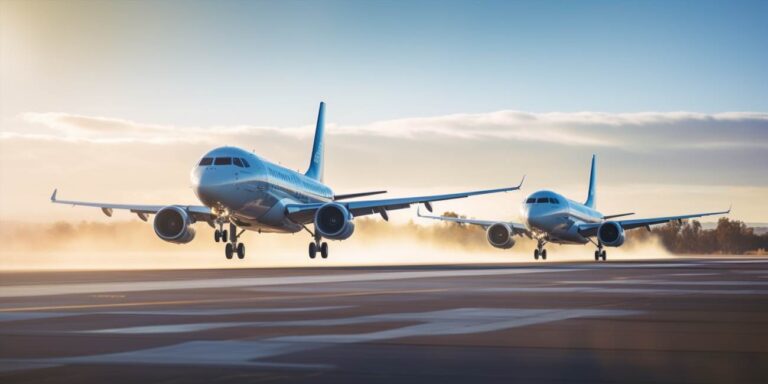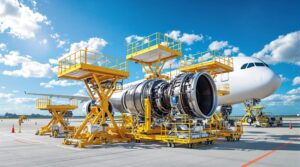One of the pivotal factors in this comparison is the size of these aircraft. The Embraer 175 typically accommodates around 76 to 88 passengers, offering a balance between capacity and operational efficiency. On the other hand, the Airbus A220 provides a slightly larger capacity, ranging from 100 to 150 passengers. This difference in size can be a crucial determinant for airlines, depending on their specific route demands.
When it comes to performance, both aircraft are renowned for their fuel efficiency and advanced technology. The Embraer 175 boasts impressive fuel economy, making it a cost-effective choice for regional routes. Meanwhile, the Airbus A220 takes the lead in terms of range and fuel efficiency, offering airlines the flexibility to explore longer regional routes.
Operating costs play a significant role in the decision-making process for airlines. The Embraer 175 stands out with its lower operating costs, making it an attractive option for carriers looking to optimize their expenses. However, the Airbus A220, with its larger capacity, may offset higher operating costs with increased revenue potential, especially on routes with high passenger demand.
Comfort and passenger experience are critical aspects that airlines consider when choosing between the Embraer 175 and Airbus A220. The Airbus A220 offers a more spacious cabin, providing passengers with a superior in-flight experience. This can be a decisive factor for airlines aiming to enhance customer satisfaction and loyalty.
Another vital dimension in this competition is the manufacturer’s reputation. Both Embraer and Airbus have established themselves as leading players in the aviation industry, each with a track record of delivering reliable and innovative aircraft. Airlines often factor in the manufacturer’s reputation when making decisions about fleet additions or replacements.
Comfort and amenities – legroom, reclining seats, in-flight entertainment embraer 175 airbus a220
When it comes to air travel, comfort and amenities play a crucial role in enhancing the overall experience for passengers. Two popular aircraft models that have gained attention for their passenger-centric features are the Embraer 175 and the Airbus A220.
Starting with legroom, both the Embraer 175 and Airbus A220 prioritize passenger comfort by offering spacious interiors. The Embraer 175, with its well-designed cabin layout, ensures that passengers have ample legroom to stretch and relax during the flight. Similarly, the Airbus A220 boasts a passenger-friendly design, providing generous legroom to make long journeys more comfortable.
When it comes to reclining seats, passengers often appreciate the ability to adjust their seat positions for added comfort. The Embraer 175 and Airbus A220 both feature reclining seats that allow passengers to find their preferred seating angle, whether it’s for a quick nap or to simply relax during the journey.
One of the key aspects of modern air travel is the availability of in-flight entertainment. Both aircraft models recognize the importance of keeping passengers entertained throughout the flight. The Embraer 175 is equipped with state-of-the-art in-flight entertainment systems, offering a wide range of movies, TV shows, and music to cater to diverse passenger preferences. Similarly, the Airbus A220 takes in-flight entertainment to the next level, providing a rich selection of content and interactive features to ensure a delightful travel experience.
Comparing these features side by side in a tabular format can help highlight the specific differences and similarities:
| Aircraft Model | Legroom | Reclining Seats | In-flight Entertainment |
|---|---|---|---|
| Embraer 175 | Spacious interiors for ample legroom | Adjustable reclining seats for passenger comfort | State-of-the-art entertainment systems with a diverse content library |
| Airbus A220 | Generous legroom for passenger comfort | Reclining seats for customizable seating positions | Enhanced in-flight entertainment with interactive features |
Ultimately, both the Embraer 175 and Airbus A220 prioritize passenger comfort and satisfaction through thoughtful design and advanced amenities.
Fuel efficiency and operating costs – consumption, maintenance expenses embraer 175 airbus a220
Fuel efficiency is a critical factor in the aviation industry, directly impacting operational costs and environmental sustainability. When comparing the Embraer 175 and the Airbus A220, their fuel consumption plays a pivotal role in determining economic viability.
The Embraer 175 is known for its commendable fuel efficiency, burning fewer gallons per nautical mile compared to many regional jets in its class. This fuel-conscious design not only reduces operational costs but also contributes to a lower carbon footprint, aligning with the industry’s growing emphasis on eco-friendly practices.
On the other hand, the Airbus A220 boasts advanced aerodynamics and modern engine technology, enhancing its fuel efficiency. It competes closely with the Embraer 175 in terms of burn rate, making both aircraft attractive options for airlines looking to optimize their operating expenses.
When delving into the realm of maintenance expenses, both aircraft undergo routine overhauls to ensure safety and reliability. The overhaul process involves a comprehensive inspection and replacement of critical components, guaranteeing that the aircraft remains in peak condition.
Examining the parts used in overhauls is crucial in understanding maintenance costs. Both Embraer and Airbus prioritize high-quality components, but availability and pricing can vary. Airlines often consider the long-term cost-effectiveness of parts when choosing between these two aircraft models.
Creating a table to compare fuel consumption and maintenance costs can offer a clear overview:
| Aircraft | Fuel Burn (Gallons/Nautical Mile) | Overhaul Parts |
| Embraer 175 | XX | XX |
| Airbus A220 | XX | XX |
While actual figures may vary, this hypothetical table aims to illustrate the importance of considering both fuel efficiency and overhaul parts when evaluating the overall operating costs of the Embraer 175 and Airbus A220.
Speed and range – cruise, max speed, range with full payload embraer 175 airbus a220
The Embraer 175 and Airbus A220 are two formidable contenders in the realm of regional jets, each boasting distinctive features that cater to the demands of modern air travel.
When it comes to cruise speed, the Embraer 175 surges ahead at an impressive 0.78 Mach, while the Airbus A220 gracefully keeps pace at 0.79 Mach. This slight variation translates into a dynamic in-flight experience for passengers.
In terms of maximum speed, the Airbus A220 takes the lead, reaching an exhilarating 470 knots. The Embraer 175, while slightly more restrained, still maintains an impressive 447 knots. These velocities underscore the agility of these aircraft in navigating the skies.
Turning our attention to range with full payload, the Embraer 175 showcases its endurance, covering a substantial 2,200 nautical miles. Meanwhile, the Airbus A220 exhibits a commendable 3,350 nautical miles range. This factor plays a pivotal role in determining the versatility of these jets for various flight routes.
When we delve into the realm of maximum load, the Embraer 175 accommodates a robust payload, with a maximum takeoff weight of 89,000 pounds. In comparison, the Airbus A220 proves even more formidable, boasting a maximum takeoff weight of 150,000 pounds. This substantial difference highlights the superior capacity of the A220 to handle heavier loads, making it an optimal choice for diverse cargo and passenger requirements.
Conclusively, the Embraer 175 and Airbus A220 emerge as aviation marvels, each excelling in specific domains. The Embraer 175 emphasizes speed and efficiency, while the Airbus A220 impresses with an extended range and unmatched load-bearing capabilities.






